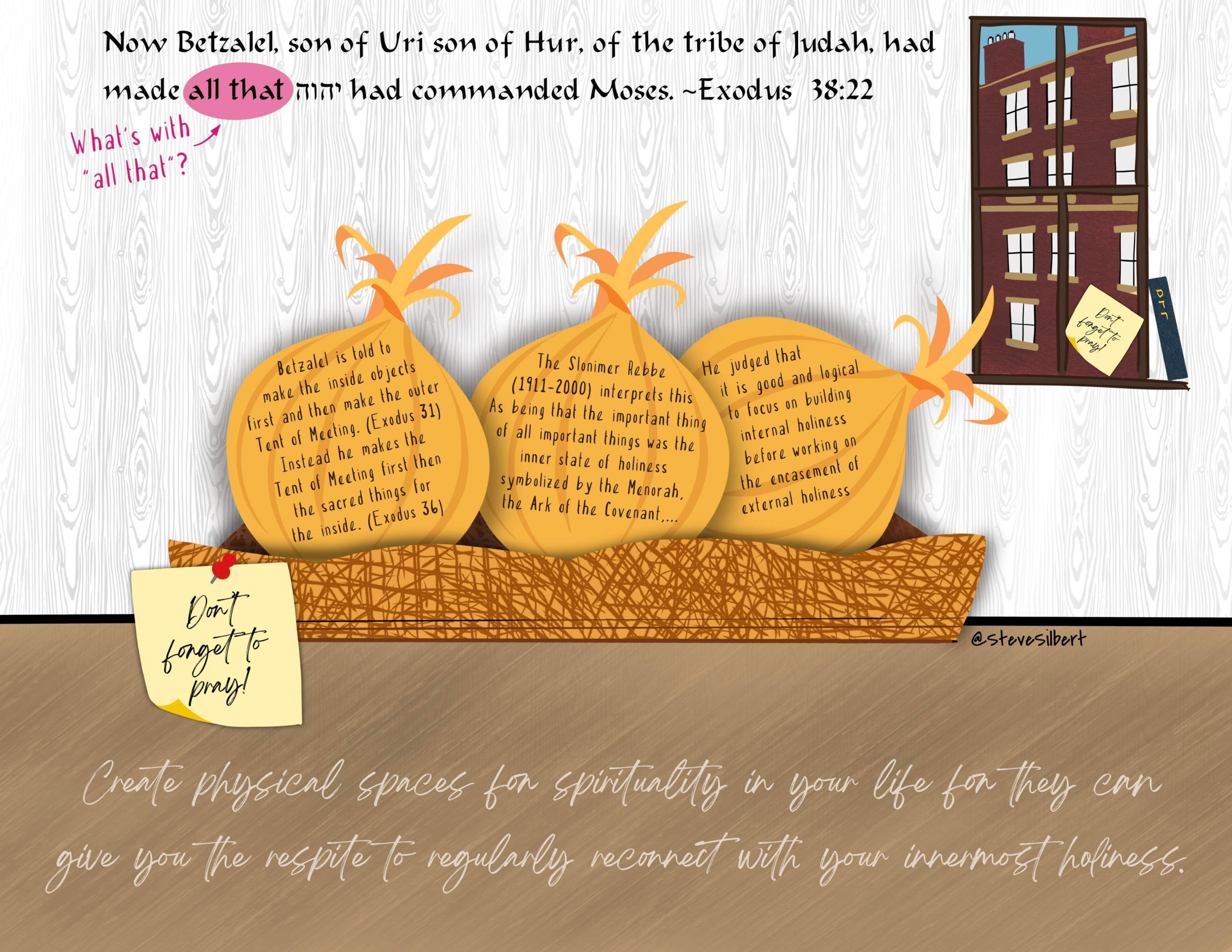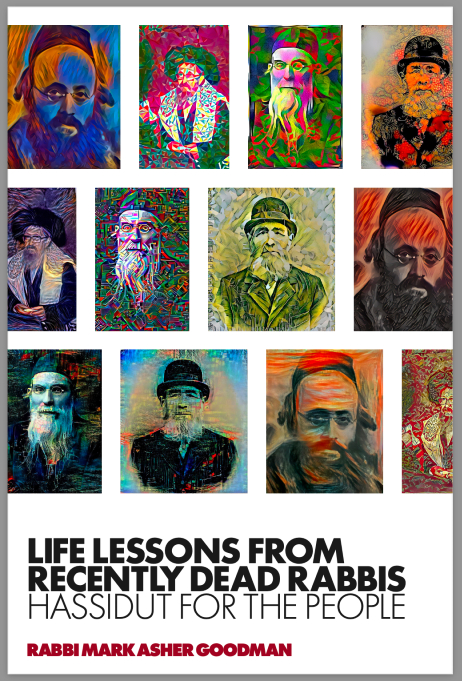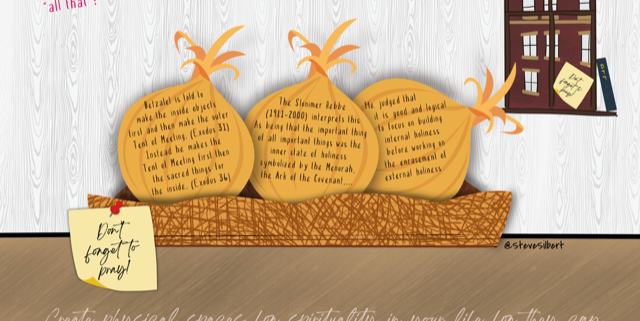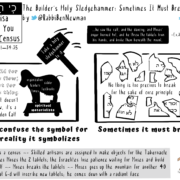Prayerbooks in Your Onion Baskets – from Life Lessons from Recently Dead Rabbis

This is an excerpt from R. Mark Asher Goodman’s Life Lessons from Recently Dead Rabbis: Hassidut for the People, now available for purchase. Illustration by Steve Silbert.
Each chapter of the book includes a question or two, a short Torah text and a related Hassidic text in Hebrew and in translation, and a d’var Torah / teaching from R. Mark Asher Goodman. Here’s the chapter for Pekudei.
Pekudei – Prayerbooks in Your Onion Baskets
Creating your sacred space — however and wherever; Sholom Noach Berezhovsky, the Netivot Shalom
Question: How do we remind ourselves of our implicit holiness? What can we do in order to sustain some kind of spiritual practice?
 Exodus 38:22
Exodus 38:22
Now Bezalel, son of Uri son of Hur, of the tribe of Judah, had made all that the LORD had commanded Moses;
ובצלאל… עשה את כל אשר צוה ה׳ את משה(לח, כב) ״את כל״ — אפילו דברים שלא אמר לו רבו הסכימה דעתו למה שנאמר למשה בסיני: משה צוהו לעשות תחלת כלים ואח״כ משכן א״ל בצלאל מנהג העולם לעשות תחילה בית ואח״כ שמים כלים בתוכו, א״ל משה — בצל א*ל היית. (רש״י)
“And Betzalel made all that God commanded Moses (Exodus 38:22)”
“All that” — even things that Moses had not mentioned, his own ideas stretched back to what Moses had said at Sinai, for Moses had instructed Betzalel to produce the vessels and furnishings , and afterwards build the tabernacle. Betzalel said to him “It is customary in the world to construct the house, and afterwards place the furnishings inside. Moses said ‘you must have been in the Shadow of God (betzel — el) , because that is precisely what God told me to do (Rashi based on Berachot 55a).”
סח בעל ״נתיבות שלום״: — לא טעה משה חס-ושלום בסדר עשייתן, גם לא שכח כיצד נצטווה, אלא הבין מדברי הקב״ה כי עיקר־העיקרים היא פנימיות הקדושה, וסמל לה: המנורה, ארון-העדות, ושאר הכלים — ממילא שפט בדעתו שכך יאה והגון להקדימם לפני הקמת אוהל המשכן, המסמל את חיצוניות הקדושה. פנימיות עדיפה על חיצוניות.
אכן בצלאל טען לעומתו כי יש ליצור תחילה את האוירה המתאימה לפנימיות זו, יש להכשיר מקום מיוחד להשראת קדושה עילאה, ורק אז יכולים להביא את הכלים לאויר העולם.
והודה משה לדבריו. אין אחיזה במציאות לפנימיות צרופה, לנקודה הטהורה, אם אין יוצרים למענה מסגרת, אוירה ורקע מתאימים, אשר בהם תוכל להתקיים…
The Netivot Shalom (Sholom Noach Berezovsky, the Slonimer Rebbe, 1911-2000) said: Moses did not err, God-forbid, in the order of instructions. Nor did he forget what he had commanded. Rather he understood from the Holy One Blessed be that the important thing of all important things was the inner state of holiness. And the symbols of that are the Menorah, the Ark of the Covenant, and the rest of the vessels. Nonetheless he judged to his understanding that it is good and logical to do them before the construction of the tabernacle, which is the symbol of external holiness.
That which is innermost is preferable to the external things.
Thus Betzalel erred in regards to it, since there is the creation first of an atmosphere which is suited for this inwardness; one must make suitable a special place which inspires the highest holiness. And only then can one bring in the vessels which will influence the world. Moses knew this. One cannot grasp in reality pure inwardness — the center point of purity — if the creations are not made in the context of a framework, an atmosphere, and a background which is fitting; for which they have a purpose to exist…
Sholom Noach Berezhovsky, the Slonimer Rebbe (1911-2000)
Prayerbooks in your Onion Baskets
The other day my wife shouted to me from the kitchen and said, “Can I take this little prayer book out of the basket of onions?” And I replied “No!” And then I explained why.
I need encouragement to do things for myself. I need motivational Google calendar-reminders in order to go for a run. I need post-it notes on the mirror that provide self-affirmation. And I scatter little prayer books (rabbis always have lots of prayer books) all over the house, in random locations, in order to remind myself to pray everyday.
Some days I say all of the morning prayers. And sometimes I just squeeze in five minutes while the stove is boiling the water for the kids’ spaghetti. And sometimes, despite passing by a prayerbook next to my bed, another in the sunroom, a third in the living room by the couch, a fourth by the lamp on the OTHER side of the couch, a fifth and sixth in the dining room, and the seventh in the onion basket … I still fail to pray that day.
Nonetheless, I am creating an atmosphere of holiness. I have placed wall hangings with spiritual themes. I have laid out my reminders to stop and center my soul regularly. I make my outsides reflect what I want my insides to absorb.
I make outer sacred reminders that encourage me to turn inward.
In our text, we get a complicated exegesis that falls at the very end of the book of Exodus. Moses is passing down the instructions for creating the tabernacle and the sacred furnishings within it to his artisan, Betzalel. Our medieval commentator par excellence, Rashi, notices a weird (and slightly complicated) problem in the Torah: the text tells us in Exodus 31 that Betzalel must make the inner sanctum (called the ‘Ohel Moed’ or Tent of Meeting), the ark, the menorah and other furnishings first, and then make the outer tented walls that we call the Mishkan or tabernacle. However, in Exodus 36:8, the order is reversed: Betzalel and his team of craftspersons make the Tent of Meeting first, and then, starting in Exodus 37, begin to make the ark, and the menorah, and several special altars.
So which came first? The chicken or the egg? The furniture, or the house? And if Betzalel reversed Moses’ instructions, why? But most importantly for our Hassidic commentator — what possible meaning could it all have?
The Netivot Shalom, also known as the Slonimer Rebbe, uses this opportunity to meditate on how we must create a framework for holiness; an atmosphere for spiritual elevation. Even the greatest spiritual masters — the Hassidim in their generation, the priests inside the tabernacle of their era — needed to craft a sacred outer space that would attune their minds properly to the contemplation and sacred exploration inside. We too can create physical spaces for spirituality in our lives and workplaces. These spaces can give us respite, helping us reconnect regularly with our innermost holiness, our purest essence.
It can be anything: our own contemplative shrine or a little fountain; a favorite bookshelf or the window in our apartment where the sun pours through at just the perfect angle every afternoon. My first spiritual ‘place’ was created with crayons and a piece of paper that I hung on the wall and used as a focal point for meditation.
A spiritual space is what you make of it, and it works if it encourages you to some act of tranquil pause that allows you to disconnect from the world and reconnect with the self. A spiritual space can even be a prayer book in a basket of onions. Whatever works for you.
That critical inner work allows us to then follow through on the words of Rabbi Berezhovsky when he says, “One must make suitable a special place which inspires the highest holiness. Only then can one bring in the vessels which will influence the world.” We make the sacred space so that we can bring the soul into it. And the soul, enlightened and refreshed, can venture forth into the world in order to add holiness into every place we go.
We create and maintain our sacred spaces so that we create and maintain our souls, and so that our souls can shine out in the world.


Rabbi Mark Asher Goodman is author of Life Lessons from Recently Dead Rabbis: Hassidut for the People. Now available — get your copy here!
Illustrator Steve Silbert, who serves on the Bayit board, is Lead Builder for Bayit Games.









